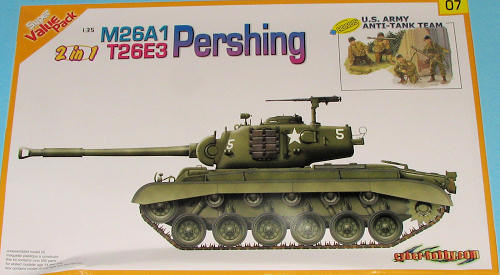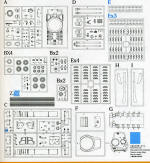
Cyber-hobby 1/35 M26A1/T26E3 Pershing
| KIT #: | 9107 |
| PRICE: | $40.00 SRP |
| DECALS: | Eight Options.95 |
| REVIEWER: | Scott Van Aken |
| NOTES: | Super Value Pack |

| HISTORY |
During the next two years, various prototypes were built under the designations T20, T22, T23, T25 and T26. These covered a variety of combinations of weapons, transmissions, and suspensions. However, the initial success of the M4 led the Army Ground Forces command (AGF) to believe that there was no urgent need for a new tank. Even with the appearance of the heavy Tiger and medium Panther tanks, the AGF did not alter its position, believing both tanks would be fielded in relatively small numbers. The AGF was correct about the Tiger, a specialized heavy tank that was never encountered in large numbers. The Panther, first encountered in small numbers at Anzio, however, was produced in very large numbers and formed half the German tank strength in Normandy. Also, according to the Army doctrine of the time, tanks were not supposed to engage other tanks; this was the task of tank destroyers, more mobile armored vehicles with powerful guns, such as the M10 tank destroyer. As a result, the development of the new tank was slow. When the Allies invaded western Europe during Operation Overlord in June 1944, the M4 still equipped the bulk of American tank units. It quickly became clear that the tank destroyer doctrine failed in the field and that even the upgunned Sherman was unable to engage the Panther on equal terms. Efforts were made to speed up development but the tank, by now called the T26 and dubbed the Pershing, reached the battlefield only in February 1945 and saw very little action in World War II.
In May 1946, due to changing conceptions of the US Army's tank needs, the M26 was reclassified as a medium tank. Designed as a heavy tank, the Pershing was a significant upgrade from the M4 Sherman in terms of firepower and protection. On the other hand, its mobility was unsatisfactory for a medium tank (it used the same engine that powered the M4A3, which was some ten tons lighter) and its transmission was somewhat unreliable. In 1948, the M26E2 version was developed with a new powerpack. Eventually the new version was redesignated the M46 General Patton and 1,160 M26s were rebuilt to this new standard. Thus the M26 became a base of the Patton tank series, which replaced it in early 1950s. The M47 Patton was an M46 Patton with a new turret. The later M48 Patton and M60 Patton, which saw service in later Vietnam and Mideast conflicts and still serve in active duty in many nations today, were evolutionary redesigns of the original layout set down by the Pershing.
| THE KIT |
 This is one of Cyber-hobby's Super Value Pack kits. Basically, it is an older kit, sometimes with upgrades and with a figure set added in. This one has set 6149: US Anti-Tank Team along with another sprue that includes a flame thrower and bazooka. Very nice addition, though perhaps it would be more useful with a Panther tank kit, eh?
This is one of Cyber-hobby's Super Value Pack kits. Basically, it is an older kit, sometimes with upgrades and with a figure set added in. This one has set 6149: US Anti-Tank Team along with another sprue that includes a flame thrower and bazooka. Very nice addition, though perhaps it would be more useful with a Panther tank kit, eh? ck guides. A few parts also need to be trimmed, but that is shown in the instructions.
ck guides. A few parts also need to be trimmed, but that is shown in the instructions.| CONCLUSIONS |
| REFERENCES |
http://en.wikipedia.org
June 2009
If you would like your product reviewed fairly and fairly quickly, please contact the editor or see other details in the Note to Contributors.
Back to the Previews Index Page